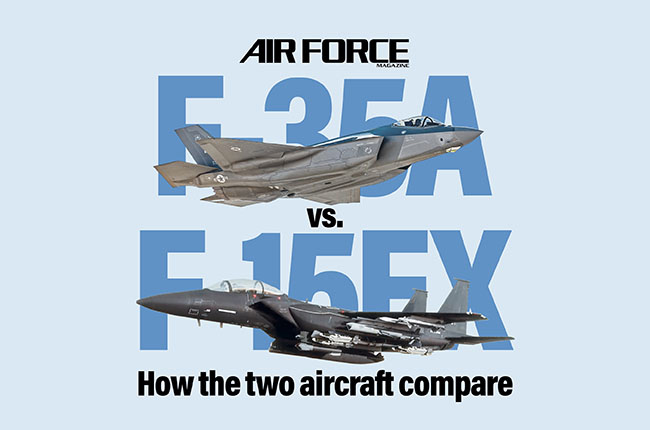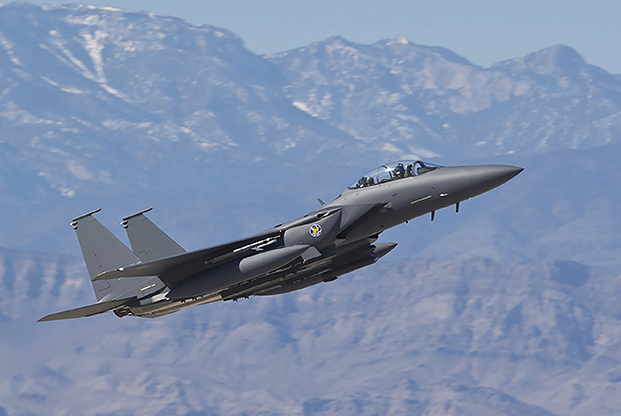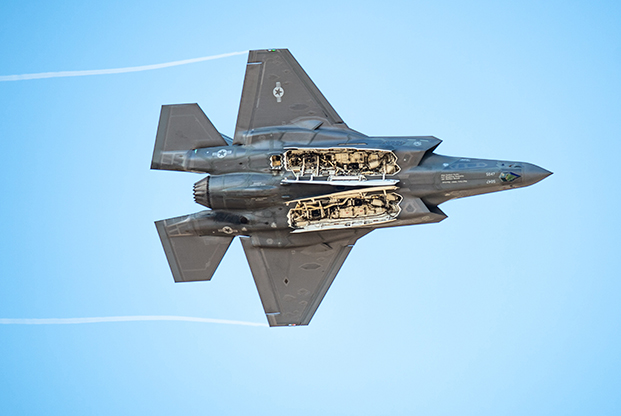
Check out Air Force Magazine‘s comprehensive infographic to learn how the F-35A and F-15EX stack up against each other when it comes to production costs, performance, fuel capacity, service life, and more.
The F-35 Lightning has been the Air Force’s sole new fighter program since 2009, when the F-22 Raptor program was prematurely terminated. While behind schedule, the program has been a top Air Force priority for more than a decade and until recently, was expected to remain USAF’s only fighter program until a future capability, still undefined, comes online.
Now the F-35 faces a new challenge from an old jet design, a variant of the F-15 Strike Eagle; an airplane from an earlier era, built for a different mission. Though the Air Force denies it, the two jets are competing for inevitably limited dollars within the service’s fighter portfolio.
The Air Force’s fiscal 2020 budget request includes $1.1 billion to buy the first eight of a planned 144 F-15EX aircraft. The new airplanes are very similar to the export versions now being built for Qatar. The F-15EX is a two-seat fighter that can be flown by one or two aviators and is meant to replace F-15Cs and Ds that are reaching the end of their service lives.
Under the plan, the Air Force would receive two F-15EX airplanes in 2022, six more in 2023, and a total of 80 airplanes in the next five years. Separately, the 2020 budget request also includes $949 million to upgrade existing F-15s.
Adding new F-15s was not an Air Force idea, but instead came out of the Pentagon’s Cost and Program Evaluation office, or CAPE, and was endorsed by former Defense Secretary James Mattis. While the Air Force’s long-held position has been to invest only in fifth generation fighter technology, it has defended the plan to buy new F-15s as a way to maintain fighter capacity, given the aging of the F-15C fleet and the slow pace of F-35 acquisitions.
While the Air Force is adamant that buying F-15EXs will not reduce the requirement to build 1,763 F-35s, history and the Air Force’s own budget request suggests otherwise. The 2020 budget submission shows the Air Force buying 24 fewer F-35s over the next five years compared to last year’s plan.
 An Advanced F-15 during system and flight control testing in Palmdale, Calif. Photo: Boeing
An Advanced F-15 during system and flight control testing in Palmdale, Calif. Photo: Boeing
The opening for the F-15EX results from the age and condition of today’s F-15Cs. Designed as air superiority fighters and first fielded in the 1970s, the F-15Cs were planned to have retired by now. But the premature termination of the F-22 after acquiring 186 aircraft—less than half the planned production—compelled the Air Force to extend their service. Now, key structural components are reaching the end of their engineered service life—so much so that many F-15Cs must operate today under significant speed and G-loading restrictions.
The Air Force’s arguments for the F-15EX turn on preserving capacity. The F-15Cs will age out of the inventory faster than new F-35s can come on line, reducing the available fighter fleet at a time when the Air Force argues it’s already seven squadrons short of the 62 officials say they need to meet the National Defense Strategy.
The F-15EX, USAF argues, is essentially an in-production aircraft. It has upward of 70 percent parts commonality with the F-15C and E already in USAF service and can use almost all the same ground equipment, hangars, simulators and other support gear as the Eagles now in service. At a unit price roughly comparable to that of the F-35, F-15 squadrons could transition to the F-15EX in a matter of weeks, whereas converting pilots, maintainers, facilities and equipment to the F-35 takes many months, the Air Force says.
The F-15EX, though, is a fourth generation aircraft which lacks the stealth characteristics and sensor fusion of the F-35 and F-22 and therefore won’t be able to survive against modern air defenses for very much longer. USAF has said that 2028 is probably the latest the jet could conceivably operate close to contested enemy airspace. However, CAPE and Air Force officials see viable continuing missions for the F-15EX in homeland and airbase defense, in maintaining no-fly zones where air defenses are limited or nonexistent, and in delivering standoff munitions.
While the Air Force has maintained since 2001 that it will not buy any “new old” fighters, and that it needs to transition as quickly as possible to an all-5th-gen force, proponents argue that buying F-15s and F-35s concurrently would fill gaps in the fighter fleet more rapidly. Moreover, USAF leaders, defending the new F-15 buy, have said that the F-35 still hasn’t proven it can be maintained at the advertised cost (comparable to the F-16, at about $20,000 per hour) and the service prefers to wait to make large bulk buys of the airplane after the Block 4 version starts rolling off the assembly line in the mid-2020s. This approach, they say, will also avoid spending large amounts of money to update earlier versions of the F-35 to the Block 4 configuration.

An F-35 performs a weapons bay door pass during Demonstration Team training over Luke AFB, Ariz. Photo: SrA. Alexander Cook
This isn’t the first time the Air Force has considered buying new F-15s, but the F-15EX isn’t the same as upgraded models previously offered by the jets’ maker, Boeing. The most recent offerings would have required extensive development work. In 2009, Boeing proposed the F-15 “Silent Eagle,” which would have added stealth characteristics. That jet would have carried weapons internally in conformal stations and featured canted vertical fins and surface treatments to reduce its radar signature. Boeing offered another concept, the “Advanced” F-15, or F-15 2040C, last year. That jet would have had a substantially increased payload and advanced avionics.
Instead, the F-15EX requires almost no new development, would be able to execute a test program very quickly, and requires minimal additional development.
Air Force officials say one potential mission for the F-15EX would be carrying “outsize” munitions, such as hypersonic missiles, and as a possible standoff weapons magazine working in conjunction with the F-22.
The F-35 and F-15EX were designed in different eras for different missions.
The F-15C was designed for air superiority in the pre-stealth era; the F-35 to be the battlefield “quarterback,” gathering vast amounts of information from behind enemy lines while executing stealthy strikes and picking off enemy fighters. Yet, as Congress decides how to invest in future aircraft, comparisons are necessary as the two planes compete for resources. Click here for a side-by-side comparison.